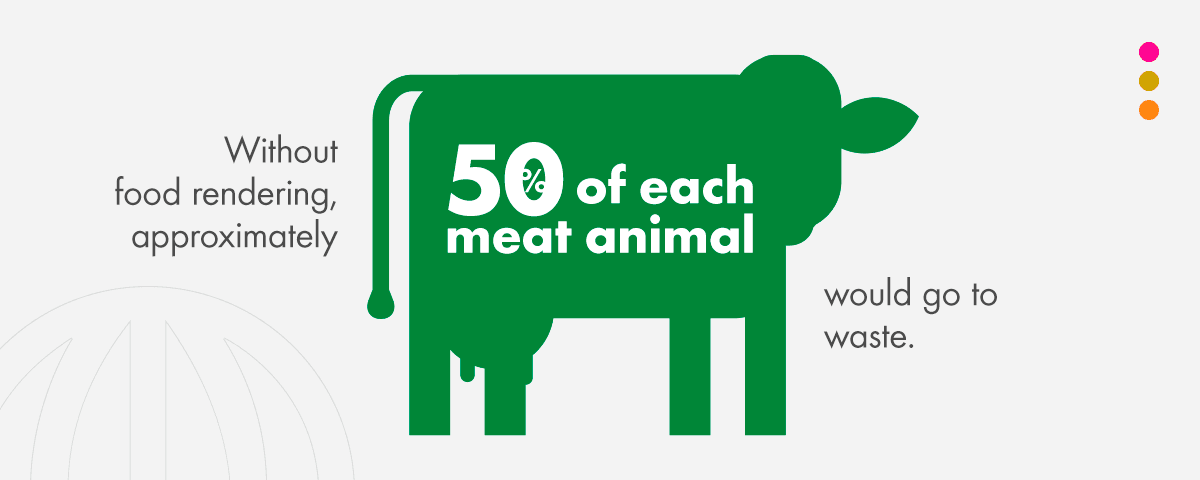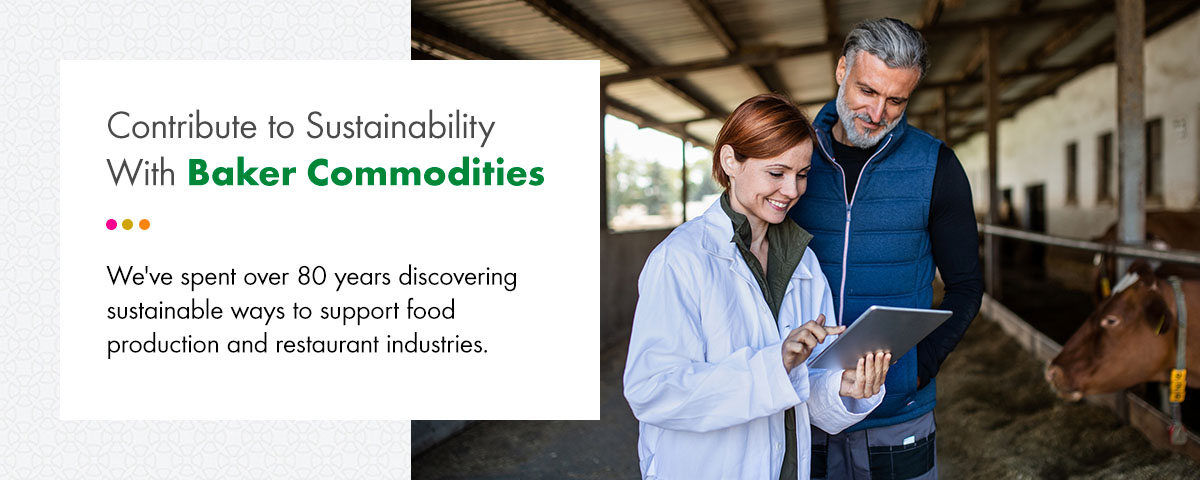How Rendering Contributes to Baker Commodities’ Sustainable Organic Recycling
Though 50% of an animal is considered inedible by meat-eaters, that doesn’t mean these by-products are unusable. However, by using animal rendering in their facilities, food production companies can reuse these unpalatable animal parts and recycle them into valuable products. Animal rendering is the process of reclaiming unwanted meat, scraps and other waste products from grocery stores and other food and agriculture industries. These unwanted items are then used to create new products, ranging from personal care products to fertilizers to rubber.
Through this method, businesses can contribute to sustainability by helping to recycle billions of gallons of water, reducing greenhouse gas emissions and minimizing landfill waste.
At Baker Commodities, we understand the value and importance of rendering. That’s why we help our customers by managing waste through our animal rendering services. We use a fleet of trucks to collect and transport animal by-products to our environmentally friendly rendering facilities, where they are processed and recycled daily.
How Sustainable Is Our Rendering Process?
Rendering processes like ours have contributed many benefits to the environment, ultimately minimizing the food production industry’s environmental footprint. Animal rendering complies with all three pillars of sustainability — environmental, social and economic. These pillars are generally accepted as the criteria for sustainable practices.
Environmental
Rendering supports the environmental pillar in all of the following key areas:
- Ecosystem services: Rendering minimizes the impact of animal agriculture by reducing food waste, water consumption and greenhouse gases.
- Green engineering and chemistry: Through rendering, businesses feed recycle 1.6 billion pounds of used cooking oils and transport them into biodiesel and renewable diesel.
- Air quality: Five times more greenhouse gases are isolated than produced through rendering.
- Water quality: Rendering reclaims billions of gallons of water that would be polluted otherwise. Instead, the water only has to go through municipal wastewater treatment.
- Stressors: Because rendering minimizes greenhouse gases, it contributes to reducing a primary environmental stressor.
- Resource integrity: By recycling unwanted by-products into animal feed, fertilizer, personal care products, commercial lubricants and other products, rendering significantly reduces food waste.
Social
The rendering process also contributes to sustainability through these social pillar components:
- Environmental justice: Businesses that utilize rendering contribute to their local communities socially and financially while investing in sustainability effort improvements.
- Human health: Renderers conduct hazard analyses and control food safety to protect consumers against bacteria and viruses.
- Participation: Animal rendering is a transparent process that complies with all applicable federal, state and local regulations according to their Rendering Code of Practice stewardship program.
Economic
Animal rendering heavily contributes to the local economy, as indicated by the economic pillar of sustainability. The rendering industry makes an economic contribution of $10 billion each year. Rendering also provides thousands of full-time jobs to American and Canadian workers, complete with competitive pay and benefits, such as liability insurance, education, 401(k) programs and health insurance. These positions are highly stable as they cannot be exported due to the raw and perishable nature of rendering materials.
How Does Rendering Reduce Food Waste?
About 108 billion pounds of food is wasted in the United States each year. These billions of pounds of food waste are disposed of in landfills and incinerators, creating greenhouse gas emissions that pollute the earth.
Rendering reduces food waste through food upcycling, which is the process of reusing food or animal by-products to establish new ways of feeding people and animals, ultimately minimizing food waste. This organic recycling process enables companies to contribute to sustainability by using food waste to produce new products, such as textiles, soap, animal feed and more.
At Baker Commodities, we offer rendering services to promote environmental sustainability in business. Through our rendering process, we recycle numerous types of food waste and convert them into usable products. Some of the waste products we recycle include:
- Hides: We clean and repair hides for use in the clothing and leather manufacturing industries.
- Feathers: Rendering services take unwanted feathers as an animal by-product and use them in fertilizers and animal feed.
- Organ meat: Since Americans don’t typically eat the meat from animal organs, we grind it up and use it in various food sources.
- Fats: Animal products typically contain high quantities of fat. Rendering implements numerous manufacturing processes for fat by-products, including deriving tallow for the cosmetics, plastics and paints industry and converting grease into biofuel or lubricant for food production equipment.
- Blood: Through the rendering process, blood is usually dried, separated and turned into feed meal and fertilizers with added nutrition.
What If Baker Commodities Didn’t Provide Rendering Services?

It’s clear that animal rendering offers numerous benefits that reduce food waste and contribute to sustainable business practices — but what would happen if companies like Baker Commodities didn’t participate in food rendering?
Without food rendering, approximately 50% of each meat animal would go to waste, filling all United States landfills in as little as four years. Because rendering significantly reduces greenhouse gas emissions, eliminating this process would increase carbon emissions from other fuel sources that aren’t as environmentally friendly.
The rendering process also helps to reduce water consumption. Without these sustainable acts, water will return to and contaminate waterways, impacting animals and people alike. If we didn’t participate in rendering, the animal agriculture industry would be more wasteful and less sustainable.
How Can Rendering and Organic Recycling Shape the Future?
Rendering is an ongoing development that creates new focuses and initiatives in various concentrations, including raw materials, environmental issues, market conditions and government regulations. In the future, it’s expected that animal rendering will go through even more advancements that positively contribute to a more sustainable future as it discovers more efficient solutions and economical equipment. Rendering is also expected to further educate consumers on the sustainable benefits of upcycling rendered materials into new products.
With continued rendering processes in business, we should expect the markets for rendered products to expand to match the estimated growth of meat production and services resulting from the increase of American and Canadian populations. As rendering continues to expand, more research investments will be necessary to continue enhancing product safety, supporting animal nutrition, improving rendering efficiency and discovering new markets for animals by-products.
Contribute to Sustainability With Baker Commodities
You can make your business more sustainable with rendering services at Baker Commodities. It’s our goal to recycle products to the highest environmental quality standards while delivering real customer service with 24-hour emergency response. We’ve spent over 80 years discovering sustainable ways to support food production and restaurant industries. In addition to our environmental protection services, we’re also committed to helping our children, raising millions of dollars for numerous local, national and international charities.
Implement organic recycling into your business by booking rendering services from us today!




